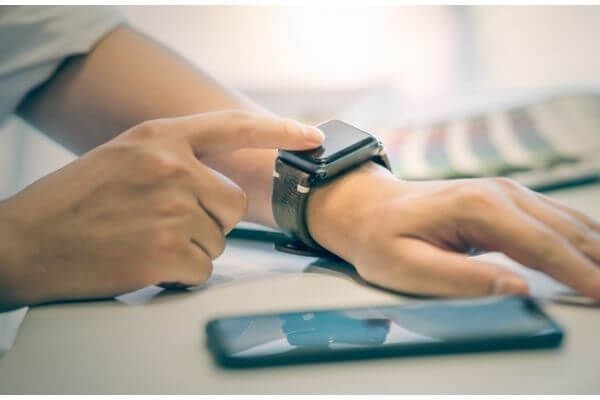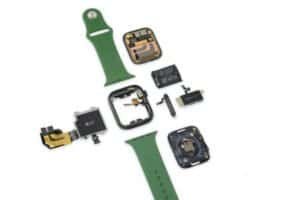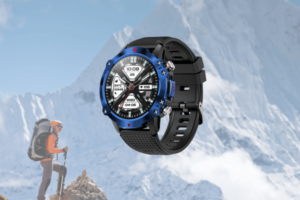Smartwatches have a myriad of benefits, but most people do not know how they work. In this article, I explain the mechanisms that enable smartwatches to do awesome stuff.
Smartwatches work with smartphones. There is usually a mobile app designed to connect with smartwatches through Bluetooth. Switch the Bluetooth on your mobile phone and your smartwatch on. Then, pair both devices. You are ready to get the best out of your smartwatch.
The subject of how smartwatches work is very broad. There are various activities that you can do with a smartwatch. Over the next subheadings, I will describe how smartwatches work for different purposes.
How Smartwatches Measure Sleep?
Many smartwatch users think, “How do smartwatches and sleep track my sleep?” It’s a simple process.
Smartwatches come with a tri-axis accelerometer. This is a minute device that monitors movement. With the use of this device, smartwatches start the process of actigraphy. Actigraphy is a process whereby your smartwatch expresses your movements as sleep patterns. The tri-axis accelerometer starts the process that determines your sleep quality through movement.
Smartwatches also check your sleep by using sensors. The tri-axis accelerometer is a type of sensor. With sensors, they watch your heart rate while you sleep. You can access the data on your smartphone or smartwatch after your sleep. This data, in turn, enables you to sleep better next time.
How Smartwatches Check Stress?
Smartwatches measure stress by monitoring your heart rate. Your heart rate is how fast your heartbeats. It is the average number of beats your heart produces per minute. Knowing this could go a long way in determining if you have stressed yourself or not.
Yet, monitoring heart rate is not enough. There are other newer ways that smartwatches detect if you’re stressed or not. The most popular is Heart Rate Variability (HRV). Heart Rate Variability is the time between each heartbeat. Generally, a high HRV is usually synonymous with being healthy. Medical professionals have linked low HRV to Heart Disease and other health issues.
Various factors affect your HRV. So, having a low or high HRV might not mean that you’re healthy or unhealthy. Posture/position and age are also factors that affect your HRV.
Your body reacts in certain ways when you have overworked it. It shows through emotion and physical strain. All these reactions affect your HRV. Smartwatches can detect these feelings and determine your stress levels.
How Smartwatches track Calories?
Fitness enthusiasts always wonder how smartwatches estimate calorie loss. They ask this question because they are skeptical about the accuracy of a smartwatch. They want to be sure that they are not given misleading information by any software. Many of them have come to trust a mobile app. They wonder if a smartwatch would have similar capabilities. Smartwatches are computers. Of course, you can rely on them to track and calculate calories. There are a few methods through which they do this.
Again, smartwatches rely on your movement to determine how many calories you burn. They use sensors to check your movements. The faster and more exerting your movements, the higher your calorie loss.
Smartwatches also estimate your burned calories by considering the muscle group that you’re exercising. Some muscle groups need more work than others to develop. Hence, training them would burn more calories. And your smartwatch will show this. Note that sometimes, you might have to input these activities into your smartwatch. Your smartwatch may not immediately notice that you are engaging in physical activity. This depends on the brand and how often you use your device.
Basal Metabolic Rate
Whether you exercise or not, you still burn calories. You burn calories when you engage your body in any form of activity. You burn calories through digestion. You burn calories when you sleep too. Smartwatches also calculate the calories burned at these times.
Basal Metabolic Rate (BMR) is the rate of energy per unit of time needed to keep your body working while you are at rest. Your BMR is what determines how many calories you can burn while at rest. Also, it accounts for about half the calories you burn every day (if you are not trying to become Mr. Olympia). There are constant factors that affect BMR. They include gender, height, weight, and age. Smartwatches usually ask you to input these factors for fitness purposes. With this information, a smartwatch can estimate how much you burn while at rest.
How Smartwatches Calculate Steps?
This is another variable that the tri-axis accelerometer helps to check. The device can detect that the wearer is on the move. You usually share personal information such as weight and height with your smartwatch. This further enables the smartwatch to know what activity is being carried out and how fast.
Many smartwatches fault at providing the accurate step count for their users. Smartwatches use motion sensors to determine these things. It is difficult for the motion sensors to determine the specific number of steps taken. Motion sensors generally detect motion. So, what’s to stop your motion sensor counting steps when you are moving your hands in the kitchen?
There are a few ways to make your smartwatch’s step count estimation more accurate. If you want to calculate steps, you could remove the tracker before other activities. Some of these activities can be mistaken as walking by the sensor. Also, you could write down your steps when you are walking. That way, you remove the mistakes and false steps from your records.
Running
Tracking steps while running can be very tricky. Your smartwatch may detect that you are running, but it might not show you. Instead, it will continue counting the steps. The device will record your steps as you run. It would seem that you are walking very fast.
Today’s smartwatches have “running mode and “walking mode.” So, if your smartwatch has this setting, you can switch to “running mode.” before a run.
How Smartwatches Check Blood Pressure?
This is usually an important one for middle-aged smartwatch users. In recent times, smartwatches have been using pulse oximetry to calculate blood pressure. Pulse oximetry happens with the use of a pulse oximeter, a sensor that illuminates the skin. It also checks the changes in light absorption.
Some watches also use heart rate measurement and ECG. The heart is an essential organ in the circulatory system. Hence, it is quite difficult to check blood without involving the heart. In smartwatches, ECGs are reliable to an extent, and they come with many wearable devices.
Blood pressure is a sensitive issue. If you have high blood pressure, you should check your BP regularly. A smartwatch will be handy for this. Still, it is expedient to go to the doctor’s from time to time for a more detailed analysis. The sphygmomanometer gives more accurate readings when it comes to blood pressure. So, you could get one for intermittent checks. Many people do not like the feel of the sphygmomanometer around their arms. So, they use the smartwatch’s estimate anyway.
Final Thoughts
Smartwatches are evolving. With more innovation, smartwatches will become more accurate. The use of motion sensors is being improved upon. Stakeholders hope that there will be more specific readings in the future.
A smartwatch’s brand is a factor that affects its technological output and efficiency. Of course, there are general mechanisms that smartwatches and other wearables work with. Nonetheless, there are discrepancies based on brand. IWO smartwatches provide overseas customers with smart wearable device solutions with market value to help win more markets. Click for a free plan.












